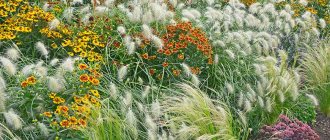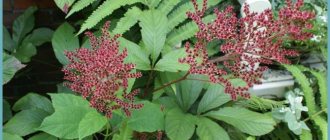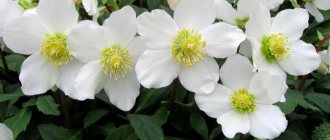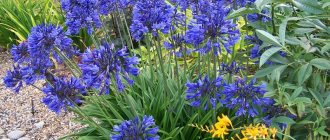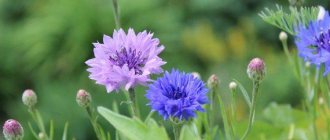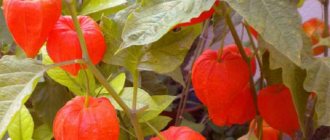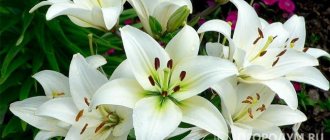Osteospermum are perennial and annual herbs, shrubs and subshrubs native to South Africa, belonging to the Compositaceae family.
Varietal diversity is used mainly for decorative purposes. Due to its direct resemblance to chamomile, the plant is often referred to as African, Cape or blue-eyed chamomile, as well as Cape daisy.
Description and features of osteospermum
Osteospermum is formed by a bush that grows up to 1 m in height, but it reaches such sizes extremely rarely and in flower beds samples of 0.5 m predominate. Usually the plant is grown by gardeners as an annual. The key feature is the aroma emitted by the foliage and stem, which have a slight pubescence over the entire surface.
Flowering begins in June and continues until the autumn cold, characterized by the abundant formation of new buds. In appearance, the flower resembles a chamomile, but with a larger palette of shades, such as light, scarlet and orange.
Dimensions vary from 2.5 to 7.5 cm; they can be seen open only in sunny weather, thus the annual protects its pollen. Osteospermum can slow down or even stop development during the summer heat, but you should not overwater the plant or start treating it. This reaction is natural and will go away on its own when the temperature returns to normal.
3.Varieties:
3.1. Noticeable osteospermum - Osteospermum jucundum
Abundantly flowering, low-growing, hardy, perennial plants, the height of which often does not exceed 15 cm. Tall varieties can reach 90 cm in height. Stems are erect and strong. The leaves are lanceolate, gray-green, and when damaged they emit a specific odor. The edges of the leaf plates can be either entire or have small denticles. Flower baskets are most often painted in shades of white, pink or lilac. There are plants with yellow baskets. The flowers reach 5–6 cm in diameter. Flowering begins in May and may end in mid-summer.
↑ Up,
3.2. Shrub osteospermum - Osteospermum fruticosum
Plants of this variety are distinguished by abundant and long-lasting flowering, as well as great resistance to stress - the bushes are easily grown in polluted spaces and can withstand serious temperature fluctuations. These herbaceous perennials grow up to 45 - 60 cm.
↑ Up,
Types and varieties of osteospermum
International organizations count about 70 species of the plant and its hybrids.
Eklona
The branched annual reaches 1 m in height. Leaves that are not wide are pointed towards the edge with several teeth.
The petals are predominantly white with veins at the base and frame a dark basket.
Hybrid varieties
| Varieties | Inflorescences |
| Zulu | Bright yellow. |
| Bambe | Shades from white to purple. |
| Sky and Ice | White, blue core. |
| Volta | The pink petals turn white as they bloom. |
| Buttermilk | Bright yellow, fades during flowering. |
| Silver Sparkler | White. |
| Congo | Purple, pink. |
| Pemba | Half collected with a tube. |
| Sandy Pink | Pink. |
| Starry Ice | Blue inside, white outside. Spoon-shaped reed inflorescences. |
Noticeable
Low annual, up to 0.5–0.7 m in height. Flowers change color as they bloom.
Hybrid varieties
| Varieties | Inflorescences |
| Buttermilk | The yellowish tint gives way to bronze on the shadow side. |
| Lady Leitrim | Lilac petals frame a dark core. |
| Sparkler | White with blue. |
Shrubby
Small dimensions are compensated by a high density of flowers on one bush.
Hybrid varieties
| Varieties | Inflorescences |
| Akila | Includes a varied palette - from white to purple tones. |
| Passion | The inflorescences are simple lilac, pink or white, about 5 cm. Decorated with longitudinal stripes. |
| Ice White | Clearly defined white petals frame a dark core with an admixture of yellow stamens. |
| Sunny Philip | The purple edges curl up and form a tube shape, the rest of the area is white. |
| Double Parple | A characteristic purple color, the petals are tubular in the center. |
Reproduction of osteospermum
It is produced by seed and cuttings, but the latter is only suitable for indoor samples.
Propagation by seeds
To avoid problems associated with picking, large seeds are initially planted in separate cup containers. The best time to do this varies and depends on the region. According to the Lunar calendar, it is necessary to plant in April.
The soil is loose and well permeable to moisture. It includes:
- Sand;
- Peat;
- Sod land.
For convenience, you can plant the seeds in peat tablets - this will allow you to no longer fertilize the osteopermum, since the soil will already be saturated with all the necessary nutrients. This method guarantees the safety of the root during replanting. In order to plant a plant correctly you need to:
- Place the seed in the soil to a depth of no more than 0.5 cm;
- Cover the container with glass or polyethylene;
- Leave in a warm, dry place for 1 week.
It is noteworthy that the sowing process does not involve pre-soaking the seeds; this is due to the characteristics of ostespermum, which is very sensitive to excess moisture.
After a week, it is worth placing the seedlings on the windowsill; the favorable temperature for them will be about +18 °C. The seedlings will begin to stretch out when there is a lack of natural light; this can be replenished by using an additional source; phytolamps are perfect. It is worth considering that the recommended daylight hours should last about 14 hours. It is important to ensure regular but moderate watering, since if the water stagnates, the osteospermum may rot.
15 days before transplanting the plant into open ground, it begins to harden. To do this, you should take the seedlings outside for a few minutes, gradually increasing the time spent in the fresh air. When the threat of frost has passed and the weather characteristic of May has established itself, you can replant the plant in open ground, but it is necessary to maintain a distance of 0.5 m between seedlings.
When propagating osteospermum with seeds that were collected in your own garden, you should not expect to receive similar samples; this applies most of all to terry varieties.
Propagation by cuttings
It is preferable to carry out cuttings no later than April. For propagation, cuttings from the top of an already mature plant are suitable. It is necessary to cut off those that reach 7 cm in length. The lower leaves should be removed and the cut renewed. Then, slightly tilted, the seedlings are placed in a substrate consisting of sand and vermiculite. Then you should create a greenhouse effect by covering the container with polyethylene and placing it in a well-lit place. Then you need to regularly ventilate and water the cuttings. In just 2 weeks they will take root.
Questions - answers
Is it perennial or annual?
Among the diversity of plants included in the genus, there are both annual and perennial representatives. However, depending on climatic conditions, some perennials are cultivated as plants with an annual development cycle.
Are dimorphotheca and osteospermum the same thing or not?
Although the plants belong to the same Asteraceae family and have quite a lot in common (which is why confusion arises), they are different species. They differ in the structure of the bud, leaves and seed shape.
Why doesn't it bloom?
A possible reason for the lack of flowering is too high an air temperature. The fact is that if the weather is too hot, the formation of buds in Cape chamomile is suspended, and all forces are redirected to the formation of testes. Another possible reason for the lack of osteospermum flowering is excess nitrogen in the soil.
Planting and care in open ground
An open, well-lit place is preferable for a sun-loving plant; a little shade is also acceptable.
Basic soil requirements:
- Acidity is about 7 pH, slightly acidic is also allowed;
- Moderate fertility;
- Looseness;
- Water and breathability.
It is first necessary to dig up the soil, making it loose, leveling it and allowing sufficient time for settling. The earthen ball cannot be destroyed, so it is worth considering its volume when digging holes. After planting, it is necessary to lightly compact the soil around and moisten it abundantly.
The saturation of flowering depends on the regularity of watering during this period, but the rest of the time it is worth moisturizing as needed.
Pinching and feeding
The branchiness of the plant directly depends on timely pinching. First of all, this concerns the tops of the shoots. Also, cultivation is not complete without the use of mineral fertilizers 3 times per season:
- 15 days after planting in open ground;
- At the bud setting stage;
- On the eve of autumn.
To maintain a decorative appearance, it is important to promptly free the plant from fading inflorescences.
Wintering of osteospermum
Osteospermum can safely overwinter only in relatively warm regions, that is, those where the minimum temperature will not fall below -10 °C. In this case, the flower needs additional insulation, for example, it can be covered with dry leaves.
If the temperature range does not meet the requirement, you should resort to the following actions:
- Carefully remove the bush without damaging its root system;
- Place in a wide container;
- Leave at a temperature not lower than -10 ° C and water occasionally;
- In spring, plant osteospermum back.
A shrub that has overwintered outside should cut off all its stems in the spring.
Diseases and pests
Osteospermum is not attacked by most insect pests common in mid-latitudes; the situation is similar with diseases. Excessive moisture can harm the shrub, which provokes rotting of the roots. In this case, the bush should be treated with fungicides.
It is not always possible to cure a plant, so it is worth taking timely preventive measures that will help maintain the health of the bush. Disease prevention includes:
- Timely weeding;
- Proper seed storage;
- Regular monitoring of soil pH, both too low and excessively high levels of acidity are unacceptable;
- Constant weeding, proper moisture;
- Maintaining soil looseness;
- When removing residual plant fragments, it is important to prevent them from overwintering in the ground.
In the absence of other food sources, the aphids will start eating osteospermum. Characteristic symptoms will be yellowing and falling leaves. To get rid of the pest, just spray the bush with insecticides; traditional methods, for example, a soap solution, are also suitable. To make it, you need to take 1-2 cups of ash and pour 10 liters of boiling water with 1/7 of a standard piece of laundry soap, which must first be crushed into shavings. Then leave the solution to sit overnight. Before spraying, sift through cheesecloth. Excellent for protecting young plants.
Mr. Summer Resident recommends: ideas for placing Cape chamomile in the garden
The plant looks great in both the landscape of large and small gardens. Planted as a border plant, combined with stone compositions, also suitable for mixed flower beds and mixborders. Its unpretentious appearance makes the plant universal and can be combined with a large number of plant species and varieties.
Used to decorate lawns, it will attract attention even to a lonely bush. Compact varieties are suitable for planting in pots, for hanging flowerpots, balconies and terraces. It would be a good idea to tie up the stems if the bush’s splendor does not allow it to maintain its shape. Dwarf varieties can be used as ground cover plants. Osteospermum in white tones will create a wonderful composition with lavender, iberis, forget-me-nots and petunias.
Wintering
One-year-old osteospermum dies in winter. It can be turned into a perennial if you dig it up, plant it in a pot, and place it in a cool room (+15-17oC). Experienced flower growers advise trimming the shoots further before wintering.
Daisies bloom until November or even December. This method makes it possible to obtain cuttings for propagation without reducing their decorative qualities in winter.
The osteospermum is dormant from the end of flowering until March. At this time, watering and daylight hours are reduced, the plant is moved to a cool place (in a city apartment this is a window sill on the north side).
